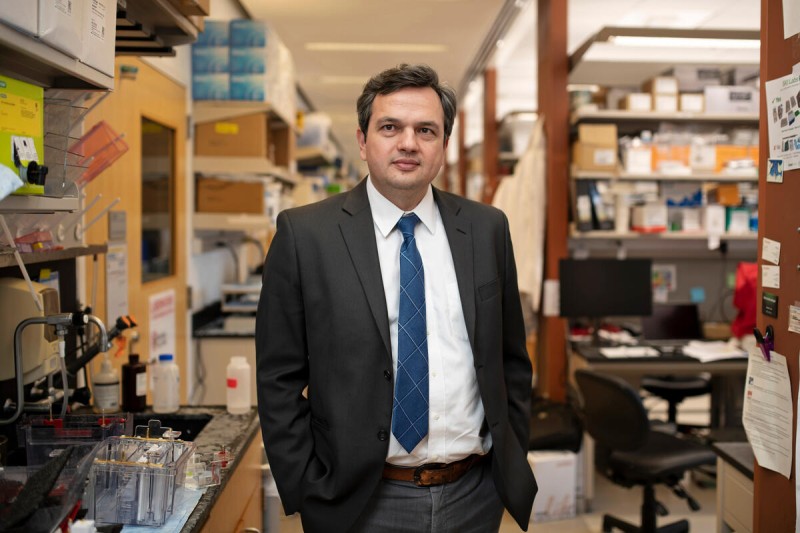
A research team led by MSK physician-scientist Dr. Piro Lito discovered that certain inhibitors can short-circuit the out-of-control signaling caused by mutations that fuel cancer growth.
Each year, more than 3 million people are diagnosed with cancers driven by mutations in three RAS-family genes: KRAS, NRAS, and HRAS. RAS-family mutations are associated with numerous types of cancer.
KRAS mutations are found in pancreatic cancer, colorectal cancer, lung cancer, and certain types of ovarian cancer. NRAS mutations are often observed in melanoma, acute myeloid leukemia, and thyroid cancer. And HRAS mutations are commonly found in bladder cancer, head and neck cancer, and certain types of skin cancer.
Now an MSK research team has identified a therapeutic approach that has shown promise in preclinical models. In a new study, scientists from the lab of Piro Lito, MD, PhD, demonstrated that certain inhibitors can short-circuit the out-of-control signaling caused by mutations that fuel cancer growth. Their findings were published on October 30, 2024, in Nature, one of the world’s leading scientific journals.
We spoke with Dr. Lito about the study’s findings and implications.
What is the function of the RAS protein? And can you explain, for non-scientists, what this research found?
RAS is a cellular enzyme that breaks down the nucleotide GTP. In doing so, it acts as a molecular switch to turn ‘on’ and ‘off’ the ability of cells to grow. Mutations — or errors in the DNA code — disrupt the ability of RAS to break down GTP, causing it to be stuck in an ‘on’ position. The RAS switch has been historically viewed as being broken in cancer, thus leading cells to grow uncontrollably.

Dr. Antonio Cuevas-Navarro
Scientists have long worked to find drugs that inhibit mutant RAS proteins. Drugs that target a certain form of RAS have been recently approved for the treatment of patients with lung cancer or colorectal cancer. These drugs work by preventing the interaction of RAS with other proteins — either proteins that regulate it, or others that mediate its oncogenic effect. Since the discovery of RAS mutations several decades ago, scientists have been searching for methods that specifically restore the defect in nucleotide breakdown caused by mutations. This, however, has proven very difficult to achieve.
Over the past several years, our work has shown that the mutant RAS switch is not broken in cancer but simply defective. We also found that some cellular proteins can turn the RAS switch off. These studies led us to search for pharmacologic methods that might fix the defective RAS switch.
In an effort led by lab members Antonio Cuevas-Navarro, PhD, and Yasin Pourfarjam, PhD, we have now identified one such approach that can restore the normal functioning of these mutated proteins by stimulating their ability to break down the nucleotide.
What do these findings mean for RAS-driven cancers?

Dr. Yasin Pourfarjam
This finding is significant because it could shift the approach to treating cancers driven by RAS gene mutations. Instead of passively blocking RAS — which has been the go-to method to date — this new approach works with the protein’s natural function, aiming to correct the very defect that drives cancer growth. Restoring the protein’s ability to turn itself off could make treatments more targeted and effective.
Our findings also broaden the possibilities for drug development. By focusing on reactivating a normal biological process rather than suppressing it, we may be able to create treatments that are both more specific to cancer cells and gentler on healthy cells. Our hope is that it may prove to be a new way of thinking about how to treat these types of cancers.
What are the next steps for this research into RAS gene-driven cancers?
The compounds we found to restore the natural function of RAS are called tri-complex inhibitors, and they are currently undergoing clinical testing in patients with lung, colorectal, or pancreatic cancers harboring a RAS gene mutation. While early reports from these trials offer optimism, it’s important to note that the trials are in early stages and currently ongoing.
Our next steps are to determine if the newly found function of these inhibitors modulates the responses of patients treated with these drugs. It is possible that the new mechanism might help us understand how resistance to treatment might arise and identify strategies for better therapeutic effects. It’s also worth noting that the impact was stronger against some types of mutant RAS proteins than others. We are currently exploring this effect further as it may help identify tailored therapeutic strategies for specific mutations.
On a broader scale, we believe that this research could lay the foundation for developing a new class of drugs that stimulate the breakdown of GTP. This is something that scientists have been trying to accomplish for decades and, if successful, could improve care for millions of people whose cancers are driven by these mutations.